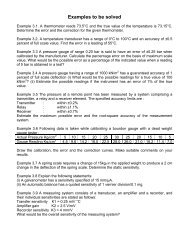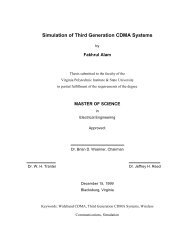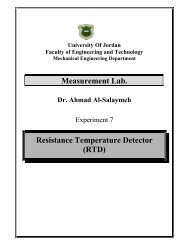In voice telephony, for example, the number of quantization levels is chosen <strong>to</strong> beL = 2 8 = 256 since intelligibility (rather than high fidelity) is required, while forcompact disc (CD) audio, the number of quantization levels is L = 2 16 = 65,536possible values per sample. Of course, the bigger value of L means a smallerquantization error range v, and thus better quality.We will discuss in class how quantization can be visualized as a noise signal. We willalso explain how adaptive quantization can improve the signal-<strong>to</strong>-quantization-noiseratio (SQNR).III. Mapping:After the analog signal is discretized in time (i.e., sampled) and value (i.e.,quantized), it is converted in<strong>to</strong> a binary bit stream using a process called mapping, inwhich each of the quantized sample values (e.g., 6V, 10V, etc) is mapped <strong>to</strong> acorresponding binary code (e.g., 0110, 1010, etc). The result is a stream of 1‟s and 0‟s.Notice that each sample is represented by n = log2 (L) bits, and hence the bit time T0is given by T0 = Ts / log2 (L), where Ts is the sample period. For example, if L = 256,we have T 0 = T s 8 (see Figure 8 below).The <strong>to</strong>tal number of bits generated in one second is called the data bit rate f0 = 1 / T0measured in bits/s (or bps) and is given by:f0 [bps] = fs [samples/s] × log2 (L) [bits/sample]m sq (t)T stT s0 1 1 0 0 1 0 0T 01 0 1 0 1 1 0 0T 0m digital (t)T s = log 2 (L)×T 0T s = log 2 (L)×T 0Figure 8. The Sampled Signal being Mapped in<strong>to</strong> 1's and 0's.6
IV. Encoding:Now that we have a bit stream of 1‟s and 0‟s, those bits are first manipulated in<strong>to</strong> anew (and better) sequence of 1‟s and 0‟s, and then converted in<strong>to</strong> voltagesappropriate for transmission on a physical channel. This manipulation andconversion is collectively called encoding. Encoding schemes are usually dividedin<strong>to</strong>: source encoding, channel encoding and line encoding (see Figure 2).A. Source coding: Source coding refers <strong>to</strong> the process of compressing data. This istypically done by replacing long binary codewords that occur frequently by shorterones, and those that occur less frequently by longer codes. For example, a 4-bitsequence “0110” occurring frequently can be mapped in<strong>to</strong> the shorter 2-bit sequence“01”, while another 4-bit sequence “1011” occurring less frequently can be mapped<strong>to</strong> the longer 6-bit sequence “111001”. This makes sure that sequences that occurmore often in the bit stream are the shorter ones.In information theory, Shannon's noiseless coding theorem places an upper andlower bounds on the expected compression ratio. Examples of source codescurrently in use are: Shannon codes, Huffman codes, run-length encoding (RLE),arithmetic coding, Lempel-Ziv coding, MPEG-2 and MPEG-4 video coding 5 , LinearPrediction Coding (LPC) and Code-Excited Linear Prediction (CELP) coding, etc.B. Channel coding: Channel coding refers <strong>to</strong> error correcting codes. The mos<strong>to</strong>bvious example of such codes is the simple parity bit system. Such codes are used <strong>to</strong>protect data sent over the channel from corruption even in the presence of noise. Inother words, channel codes can improve the signal-<strong>to</strong>-noise ratio (SNR) of thereceived signal.The theory behind designing and analyzing channel codes is called Shannon’s noisychannel coding theorem. It puts an upper limit on the amount of information youcan send in a noisy channel using a perfect channel code. This is given by thefollowing equation:C = B ch × log 2 1 + SNRwhere C is the upper bound on the capacity of the channel (bit/s), Bch is thebandwidth of the channel (Hz) and SNR is the Signal-<strong>to</strong>-Noise ratio on the channel(unitless). Examples of channel codes currently in-use include: Hamming codes,Reed-Solomon codes, convolutional codes (usually decoded by an iterative Viterbidecoder), Turbo codes, etc.C. Line coding: Line coding refers <strong>to</strong> the process of representing the final bit stream(1‟s and 0‟s) in the form of voltage or current variations optimally tuned for thespecific properties of the physical channel being used.The selection of a proper line code can help in so many ways: (a) One possibility is <strong>to</strong>aid in clock recovery at the receiver. A clock signal is recovered by observingtransitions in the received bit sequence, and if enough transitions exist, a goodrecovery of the clock is guaranteed, and the line code is said <strong>to</strong> be self-clocking. Self-5 MPEG is short for Moving Picture Experts Group.7
















